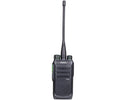
Different Types of Handheld Radios Explained
, by Joseph Gabriel, 2 min reading time

, by Joseph Gabriel, 2 min reading time

In our increasingly connected world, handheld radios remain a reliable and necessary tool for communication in a variety of contexts. Learn more about different types of handheld radios, including their notable features and ideal applications.
Ham radios, also known as amateur radios, are powerful handheld communication devices used worldwide. They operate on various frequency bands allocated to amateur radio enthusiasts for non-commercial use. The key advantage of ham radios is their ability to provide robust, long-range communication, which can extend globally with the right equipment and licensing. This makes them an invaluable tool not just for hobbyists but also for emergency services during disaster situations when traditional communication networks may fail. However, the expensive and inaccessible nature of portable ham radios means they're not commonly used for standard business applications.
CB radios, short for Citizens Band radios, are handheld two-way communication devices that operate on 40 shared channels in the 27 MHz band. Unlike ham radios, they don't require a license to operate, making them more accessible to the general public. CB radios offer reliable short-range communication, typically around 1-15 miles. The most common users of CB radios include long-haul truckers and off-roading enthusiasts. Unfortunately, CB channels are completely open to the public and, therefore, unfit for most commercial applications.
Family Radio Service (FRS) radios are user-friendly, two-way communication devices that operate on designated ultra-high-frequency (UHF) channels. These radios offer short-range communication and are typically used for family activities, outdoor recreation, and, most notably, small business operations. Their simple user interface and typically lightweight design make them easy to carry and use, especially for beginners.
General Mobile Radio Service (GMRS) radios are two-way communication devices that operate on specific frequencies around 462 and 467 MHz. Unlike FRS radios, GMRS radios require a license from the FCC for operation in the United States, but this license covers immediate family members as well. These radios offer more power than CB radios, with handheld models producing up to 5 watts of power and base station models delivering up to 50 watts of power, significantly increasing the range and clarity of radio transmissions. This makes GMRS radios ideal for short-range two-way voice communications, which is often necessary for outdoor communication, recreational activities, and commercial operations.
Understanding the different types of handheld radios available for you and your business will help you pick the ideal equipment for your application. The Atlantic Radio Communications team proudly carries a wide selection of handheld devices from many trusted and reliable brands. Browse our selection of Hytera portable radios and related products today!